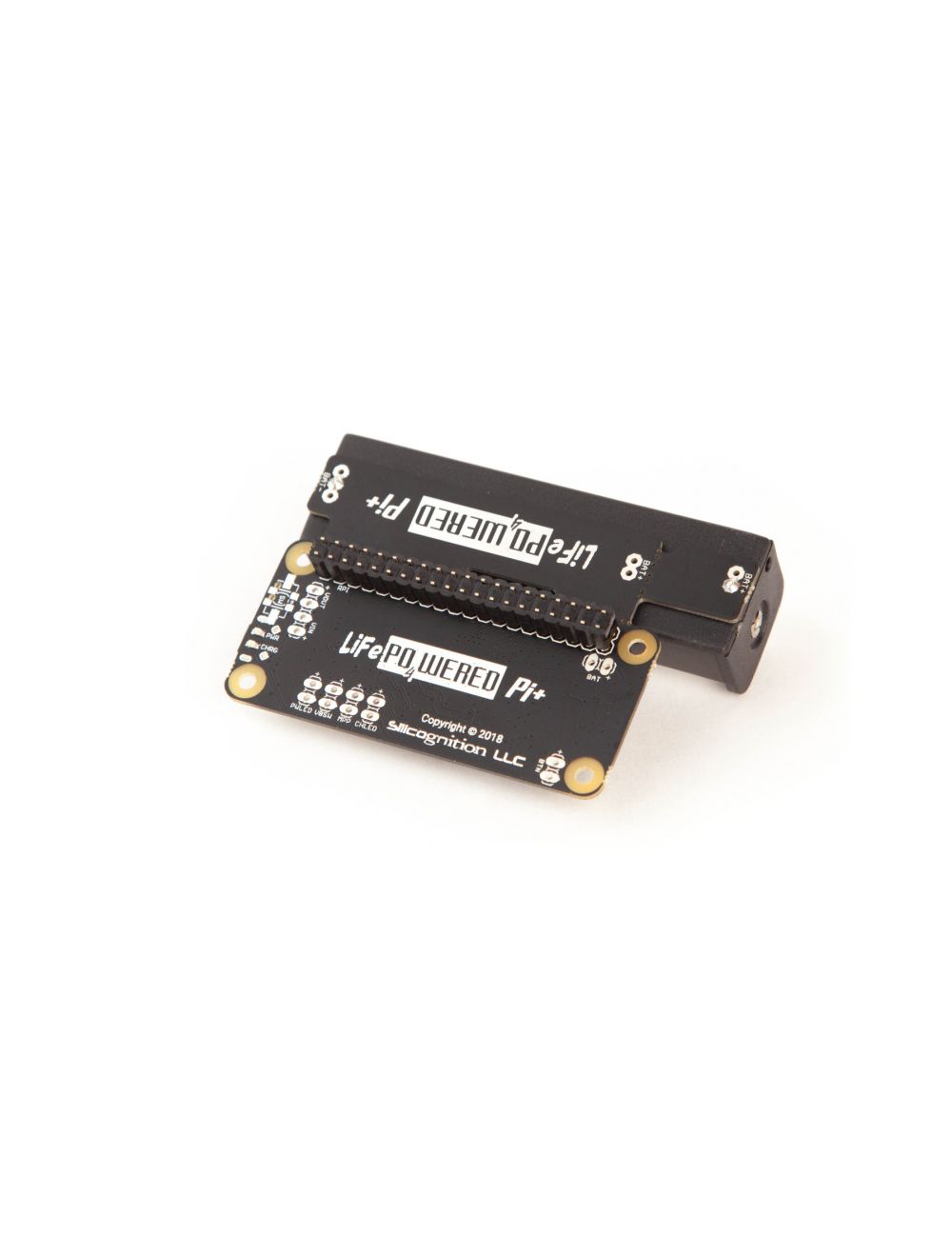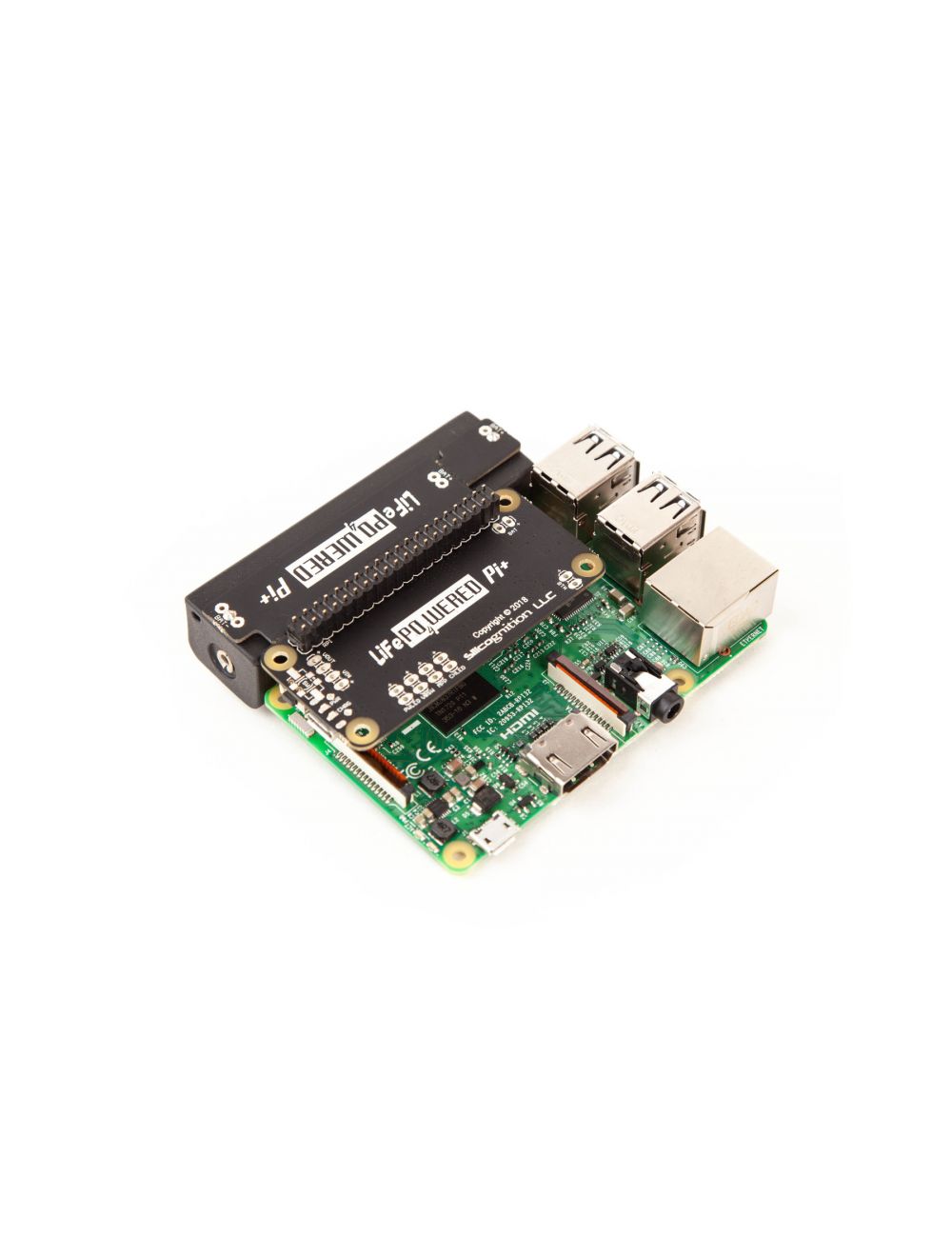LiFePO4wered Pi+ UPS for Raspberry Pi (Stackable Header)
The LiFePO4wered/Pi+™ is a high-performance battery power system for the Raspberry Pi. It can power a Raspberry Pi for up to nine hours from its battery (depending on installed battery size, Raspberry Pi model, attached peripherals, and system load) and can be left plugged in continuously.
Very few people care about power. It’s not glamorous, it’s inconvenient that you need it, and it’s an afterthought in many projects. Yet, nothing works without it. Have you noticed how many project pictures hide the power supply? Most project pictures have a cable running off somewhere; even supposedly autonomous robots often have an umbilical cord run somewhere out-of-frame. People get excited about the processor, the radio, the servos, etc., but never about the power their creation needs. With LiFePO4wered/Pi+, that’s completely fine — you can concentrate on the rest of your awesome project knowing you have a reliable, clean, battery-backed power supply that will keep everything humming along.

Features & Specifications
- Battery size:
- 18650 size: 1500 mAh 3.2 V LiFePO4 cell (full specification)
- High continuous load current whether on battery or external power
- 18650 size: maximum 2 A continuous load current
- Smart charge controller:
- Over-charge protection: allows the device to stay plugged in continuously and provides UPS functionality.
- Auto-adjusting charge current: charge current up to 1.5 A when used with high-power chargers, but automatically reduces current as needed to not overload low power sources.
- Customizable maximum power point (MPP) voltage: obtain maximum efficiency when powered directly from suitably sized solar panels.
- Smart power manager:
- I2C communication: two-way communication with the Raspberry Pi enables easy configuration, monitoring, and clean shutdown.
- Power manager and daemon: work together to ensure clean shutdowns and provide over-discharge protection, resulting in long life and high reliability.
- Continuous monitoring: input voltage, battery voltage, output voltage, and load current are continuously measured and checked against user-programmable thresholds for boot, shutdown, and hard power down.
- On/off button: provides convenient boot/shutdown triggers even in headless setups, with press and hold function to prevent accidental activation (external button can be added).
- Green PWR LED: indicates the Raspberry Pi power state, provides feedback to the user (external power LED can be added).
- Red CHRG LED: indicates power drawn from external input, whether to charge the battery or power the load (external charge LED can be added).
- Wake timer: allows the Raspberry Pi to be off most of the time and wake up as needed for low duty cycle applications.
- Real-time clock: keeps track of time when the Raspberry Pi is off and restores system time on boot, with the ability to wake up at an absolute time.
- Auto boot: can maximize uptime by making the Raspberry Pi run whenever there is sufficient battery power or when external input power is present.
- Auto shutdown: can automatically shut the Raspberry Pi down when input power is removed, either immediately or after a programmable amount of time.
- Application watchdog: can alert a user by flashing the PWR LED or trigger a shutdown/reboot if the user application fails to service the timer within a configurable amount of time.
- Open source host-side tools (see GitHub repo):
- LiFePO4wered daemon: takes care of shutdown and RTC management.
- Command line tool: allows simple configuration and access to all features.
- Shared library, language bindings: C/C++, Python, and Node.js bindings allow integration into user programs.
- Compact physical dimensions
- 18650 size: 52 mm x 75 mm
Battery Size
The LiFePO4wered/Pi+ uses 18650 size LiFePO4 cells. They are rated 1500 mAh 3.2 V LiFePO4 cell and supports up to 2 Amps of continuous load current.
Stackable Header
The LiFePO4wered/Pi+ attaches to the host board using a header and mounting kit. The stackable header allows other boards to be attached and powered.
Compatibility
The LiFePO4wered/Pi+ with 18650 battery is compatible with all modern, genuine Raspberry Pi products (Model A+, Model B+, 2, 3, 3 Model B+, 4, Zero, Zero W and Zero WH). In addition, we’ve confirmed that LiFePO4wered/Pi+ is compatible with the following non-Raspberry Pi single-board computers: Odroid C2, Nano Pi S2, Allwinner H3, and ASUS Tinker Board. The LiFePO4wered/Pi+ was designed to work with most single-board computers with a Raspberry Pi-compatible GPIO footprint. High power boards may only work with modification to heat sinks or using extra headers for spacing may be necessary.
Expansions & Modifications
The LiFePO4wered/Pi+ was designed with hackability in mind. There are convenient connection points for easily expanding and modifying its functionality. Some examples:
- Add a case-mounted on/off button.
- Add a case-mounted LED to indicate charging state.
- Add a case-mounted LED to indicate power state.
- Add a resistor to adjust the maximum power point (MPP) for use with solar panels.
- Connect external loads, such as a case fan, to either 5 V or the battery voltage.
- Take out the battery or snap off the whole battery compartment along the perforations and use with bigger LiFePO4 cells.
Lithium Iron Phosphate: a Primer
Lithium Iron Phosphate (LiFePO4 or LFP) batteries are ideally suited for use in an uninterruptable power supply (UPS) because they are:
- Powerful: deliver high continuous load current
- Long-lasting: thousands of recharge cycles, not hundreds
- Safe: don't catch fire or explode
- Stable: 3.2 - 3.3 V during most of discharge
- Durable: low self-discharge rate, no memory effects, no degradation from extended charging
- Environmentally friendly: no heavy metals, RoHS compliant, reusable thousands of times
- Adaptable: operate in cold (down to -20°C) and hot (up to 60°C) environments
| Compatible with | Raspberry Pi 4, Raspberry Pi 3 B+, Raspberry Pi 3 A+, Raspberry Pi 3 B, Raspberry Pi 2, Raspberry Pi 1 B+, Raspberry Pi 1 A+, Raspberry Pi Zero (No Camera Port), Raspberry Pi Zero (Camera Port), Raspberry Pi Zero W |
|---|















